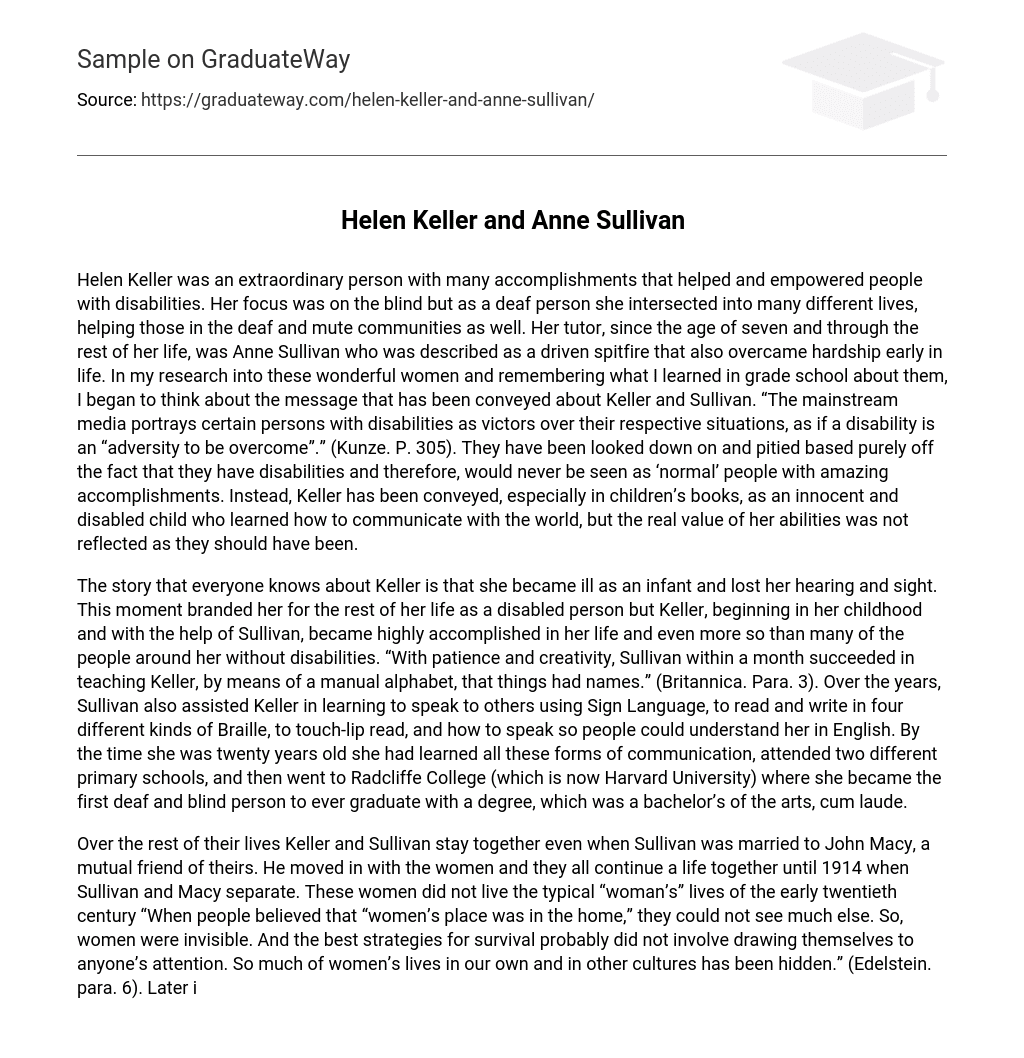Helen Keller was an extraordinary person with many accomplishments that helped and empowered people with disabilities. Her focus was on the blind but as a deaf person she intersected into many different lives, helping those in the deaf and mute communities as well. Her tutor, since the age of seven and through the rest of her life, was Anne Sullivan who was described as a driven spitfire that also overcame hardship early in life. In my research into these wonderful women and remembering what I learned in grade school about them, I began to think about the message that has been conveyed about Keller and Sullivan. “The mainstream media portrays certain persons with disabilities as victors over their respective situations, as if a disability is an “adversity to be overcome”.” (Kunze. P. 305). They have been looked down on and pitied based purely off the fact that they have disabilities and therefore, would never be seen as ‘normal’ people with amazing accomplishments. Instead, Keller has been conveyed, especially in children’s books, as an innocent and disabled child who learned how to communicate with the world, but the real value of her abilities was not reflected as they should have been.
The story that everyone knows about Keller is that she became ill as an infant and lost her hearing and sight. This moment branded her for the rest of her life as a disabled person but Keller, beginning in her childhood and with the help of Sullivan, became highly accomplished in her life and even more so than many of the people around her without disabilities. “With patience and creativity, Sullivan within a month succeeded in teaching Keller, by means of a manual alphabet, that things had names.” (Britannica. Para. 3). Over the years, Sullivan also assisted Keller in learning to speak to others using Sign Language, to read and write in four different kinds of Braille, to touch-lip read, and how to speak so people could understand her in English. By the time she was twenty years old she had learned all these forms of communication, attended two different primary schools, and then went to Radcliffe College (which is now Harvard University) where she became the first deaf and blind person to ever graduate with a degree, which was a bachelor’s of the arts, cum laude.
Over the rest of their lives Keller and Sullivan stay together even when Sullivan was married to John Macy, a mutual friend of theirs. He moved in with the women and they all continue a life together until 1914 when Sullivan and Macy separate. These women did not live the typical “woman’s” lives of the early twentieth century “When people believed that “women’s place was in the home,” they could not see much else. So, women were invisible. And the best strategies for survival probably did not involve drawing themselves to anyone’s attention. So much of women’s lives in our own and in other cultures has been hidden.” (Edelstein. para. 6). Later in life they had another female addition to the twosome, Polly Thompson who acted as secretary, assistant and took care of both of them until they died. I think that they were able to get away with this abnormal lifestyle because of their disabilities and popularity in the world.
In Keller’s eighty-seven years of life, she wrote five books about her experiences as well as a book on religion, one on social problems, a biography of her tutor, Anne Sullivan, and articles for the blind in worldwide magazines. She also made a movie called, “Deliverance” followed by a couple of years performing vaudeville to earn some money for her and Sullivan. She opposed World War I but supported World War II and did many speeches on women’s and liberal rights, including supporting birth control. Because of all her celebrity ties she was also able to secure many donations to the American foundation for the blind when she joined in 1924 and later went overseas to advocate for them which is why they ended up naming their overseas branch Helen Keller International, after her death. Obviously, Keller reached a lot of people’s hearts and created change for many. From her speeches to an award-winning play based off one of her books, people everywhere knew who she was, school children, celebrities, and presidents, still know her name today.





